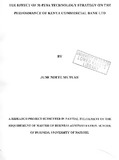| dc.description.abstract | The spread of mobile phones across the developing world is one of the most remarkable
technology stories of the past decade. Buoyed by prepay cards and inexpensive handsets,
hundreds of millions of first-time telephone owners have made voice calls and text
messages part of their daily lives. However, many of these same new mobile users live in
informal and/or cash economies, without access to financial services that others take for
granted. Indeed, across the developing world, there are probably more people with
mobile handsets than with bank accounts. Various initiatives have been used mobile
phones to provide financial services to “the unbanked.” These services take a variety of
forms—including long-distance remittances, micropayments, and informal airtime
bartering schemes—and go by various names, including mobile banking, mobile
transfers, and mobile payments. Taken together, they are no longer merely pilots; in the
Philippines, South Africa, Kenya, and elsewhere, these services are broadly available and
increasingly popular. Kenya commercial bank ltd is a leading and dominant Kenyan bank
with a strong countrywide presence. The bank remains very strong in key parameters
with the largest balance sheet (KShs 251.4billion), capital base (Kshs 39.1billion) and a
branch network (218) as at 2010. To better its way of doing business and align to current
practices including the statutory requirements, the bank’s structures, processes and
systems have continued to change. This research was conducted to establish the effect of
the M-pesa technology strategy on the performance of KCB ltd. The researcher used case
study design since the research is descriptive in nature. Both the primary and secondary
sources of data were used to obtain information for the study. Respondents were three
employees in the Money Transfer Services department in Kenya Commercial Bank Ltd. The interview guides were administered through a face to face interview. The researcher
used Content Analysis to analyze the data, because content analysis involves observation
and detailed description of objects, or things, and the errors which occur during the study
are easily detected and corrected. The introduction of the topic is covered in Chapter
one, literature review in chapter two covers the theoretical and empirical materials,
chapter three covers the methodology used, while chapter four and five are the research
findings and summary of the findings respectively.The research findings show that Kenya
commercial bank took a beneficial strategic step to keep up with the dynamic market.
What drives a business growth is technological innovation and successful management
lies in skilful allocation of resources to bring about the technological change. There has
been increasing importance of technological innovation and strategy guiding the
acquisition and deployment of technological resources for competitive growth. The bank
industry has come up with technological strategy to keep up with the expectations of the
customers. However there are various challenges which are associated with M-pesa
technology strategy, these being the system being prone to fraudsters, systems upgrades
which leaves the customers disappointed and difficulties in reconciliations of the
accounts when the transactions are many or when there are system errors. | en |

